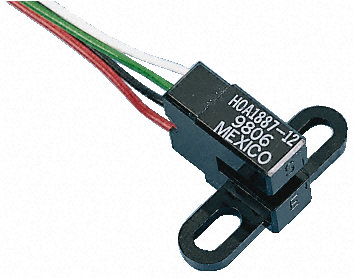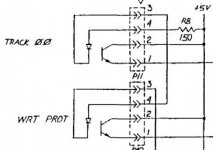When a drive is powered up, normally it will step IN towards the spindle a specific number of steps (after the Track 0 Sensor turns off) off the Track 0 indicator, and then steps OUT (towards the outer edge of the disk) until it get a Track 0 indication from the Track 0 Sensor to calibrate Track 0.
If the drive is stepping in on power up, and continues to step In towards the spindle until it hits the mechanical stop at the high Track, and stops stepping in when the Track 0 Sensor is disconnected, and starts stepping out, then the Track 0 Sensor is bad. Either the sender side is not sending, or the Receiver side is not receiving. The drive thinks the heads are on Track 0 no matter how many times it steps the heads towards the inside (which is why it keeps stepping in). If you disable the Track 0 Sensor, I would think that the Stepper motor would first step IN, and then step OUT and continue to try to step OUT even after the head assembly hits the mechanical stop.
Many of the parts on 8" floppy drives were made specifically for a particular Brand and Model of Drive. I remember seeing new optical sensors for Shugart and Siemens 8" floppy drives for years in bins in surplus electronics stores. I never saw many parts for Tandon 8" floppy drives in surplus stores. About the only way that you are going to get an exact replacement is going to be taking it off a donor Tandon 848E drive if you can find one or have one (I don't remember if the belt drive models used the same Track 0 Sensor). The TM848E drives are much more scarce than the older belt drive TM848 drives. Those sensors are some of the only relatively reliable parts that were installed on Tandon drives. The odds are, that if you can find a 848E drive to use for parts, and if the sensor is on it, the sensor will be good.


